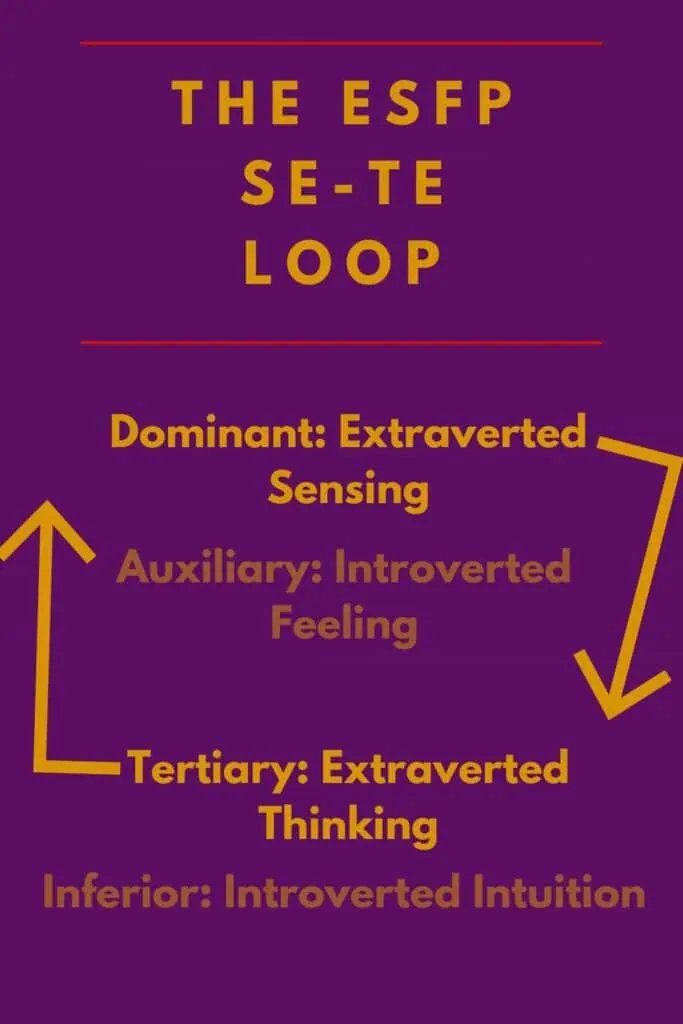The ESFP Se-Te Loop: What It Is and How to Cope
Do you ever feel like you’re stuck in an impulsive cycle that you can’t escape from? Do you find yourself making rash decisions or getting consumed in busywork only later to regret it? If you’re an ESFP, this may be a result of being caught in a Se-Te loop.
A Se-Te loop is what happens when an ESFP cycles back and forth between their dominant and tertiary cognitive functions, bypassing their auxiliary and inferior functions. If you’re new to type, you may be confused by this. That’s okay! We’re not going to try to overwhelm you with a bunch of jargon. So let’s start at the beginning.

Not sure what your personality type is? Take our in-depth personality questionnaire here. Or you can take the official MBTI® here.
What is an ESFP personality type?
ESFPs, often referred to as the ‘Entertainers’ or ‘Champions’, are one of the sixteen personality types described by the Myers-Briggs Type Indicator (MBTI®). Characterized by their boundless energy, enthusiasm, and a zest for life, ESFPs are driven individuals who love responding to life as it happens. They often have a friendly, active lifestyle and want to make a difference in the world in meaningful, hands-on ways. Equal parts practical and playful, ESFPs are fond of entertaining, connecting, and spontaneously experiencing all the beauty in each moment.
Understanding the ESFP Acronym
Let’s break down what each letter in the ESFP acronym stands for, as per the Myers-Briggs Type Indicator (MBTI®).
- E (Extraversion): The ‘E’ in ESFP stands for ‘Extraversion’. ESFPs are energized by interactions with people and the outside world. They prefer to learn and process information through direct experience, thriving in dynamic and action-oriented environments.
- S (Sensing): The ‘S’ denotes ‘Sensing’, which entails that ESFPs are conscious of details and grounded in the here-and-now. They are highly observant and rely on tangible facts and experiences rather than abstract concepts or theories. They derive joy from experiencing the world through their senses.
- F (Feeling): ‘Feeling’ is represented by ‘F’. This dimension indicates that ESFPs make decisions based on personal values, emotions, and the potential impact on others. They think about how decisions will impact others, and how those same decisions will align with their values before thinking of logical considerations.
- P (Perceiving): The ‘P’ stands for ‘Perceiving’, suggesting that ESFPs prefer a flexible and spontaneous approach to life, rather than a structured, planned one. They are adaptable, open to new experiences, and are more process-oriented rather than goal-oriented.
The cognitive functions of an ESFP
The ESFP personality type operates primarily through four key cognitive functions. Two are extroverted and two are introverted. This is important because it keeps us balanced! Carl Jung, the father of psychological type, himself said, “There is no such thing as a pure introvert or extrovert. Such a person would be in the lunatic asylum.” So even ESFPs have an introverted side!
Let’s break the ESFP’s cognitive functions down:
- Extraverted Sensing (Se): This is the dominant function of ESFPs. It’s what allows them to be in tune with their environment, to absorb sensory details in real-time, and respond quickly to changes. They are exceptionally skilled at noticing and appreciating the world around them, making them spontaneous, adaptable, and hands-on in their approach to life.
- Introverted Feeling (Fi): This is the auxiliary function for ESFPs. It’s the driving force behind their strong internal values and emotions. They use Fi to make decisions based on what aligns with their core values and what feels authentic to them. This function contributes to their passionate, empathetic, and sometimes fiercely individualistic demeanor.
- Extraverted Thinking (Te): This is the tertiary function of ESFPs. Te allows ESFPs to organize their external world, plan their actions, and make logical decisions. It’s what propels them to take immediate, tangible action on their insights and ideas, creating a dynamic interplay with their dominant Se function.
- Introverted Intuition (Ni): This is the inferior, or least developed, function for ESFPs. While it’s not as strong as the others, Ni still plays a crucial role. It helps ESFPs understand deeper meanings and patterns, and when developed, can add a layer of introspection and long-term planning to their personality. However, when this function is underused, it can lead to impulsive decision-making and lack of introspection.
But What is the Se-Te Loop?
The Se-Te loop, in simple terms, is like being caught in a whirlwind of activity without taking the time to check in with your feelings or reflect on the deeper meanings of things. As an ESFP, your natural inclination is to experience the world around you in real-time and take quick action (that’s your Extraverted Sensing or Se) and then organize these experiences and actions logically to achieve your goals (that’s your Extraverted Thinking or Te). But without the balance of your Introverted Feeling (Fi) and Introverted Intuition (Ni), you might end up in this Se-Te loop.
Imagine this: Your friend invites you to an impromptu road trip. Your Se kicks in, and you’re all for the adventure, soaking up the excitement of the new landscapes and experiences. Your Te then steps up, helping you plan out the route, manage the fuel costs, and ensure the journey is efficient. However, because you’re so caught up in the action and planning, you might ignore your Fi’s need to reflect on whether this trip aligns with your long-term values, or your Ni’s need to understand the deeper significance of this adventure in the long run. Because you’ve bypassed these important introspective steps, you might later find yourself drained, feeling out of alignment with yourself, or even regretting the decision to go on the trip. That’s just one example of how the Se-Te loop can show up.
Here’s another scenario: You’re an ESFP who’s recently started a new job in a fast-paced corporate environment. Your Se-Te loop is in full swing as you throw yourself into your work, constantly absorbing new information and making quick decisions to keep up with the rapid pace. Your Te thrives in organizing this whirlwind of activities, efficiently planning your tasks and objectives to climb the professional ladder swiftly. However, in this flurry of external activities and logical planning, your Fi – your emotional compass and value system – is sidelined.
You’re working late hours, neglecting your personal life and hobbies, and even ignoring the fact that the corporate culture might not align with your core values. You keep pushing forward, not taking a step back to introspect on whether this job truly harmonizes with your authentic self and long-term happiness. At some point, you may begin to feel discontent or burnout, without understanding why, because you’ve bypassed those essential moments of introspection and emotional reflection. This is another illustration of the Se-Te loop at play.
The key to personal growth for an ESFP, then, is to be mindful of this loop, and consciously make time for introspection and reflection, thus integrating Fi and Ni into their decision-making process.
How ESFPs Feel When They’re in a Loop:
When ESFPs are in an Se-Te loop, their emotions may be characterized by a sense of restlessness, distractibility, impatience, and a scattered state of mind. The constant need for new sensory experiences (Se) and the subsequent logical organization of these experiences (Te) can create a non-stop cycle of action and planning that leaves little room for pause or inner reflection. They may feel like they’re always on the go, jumping from one activity to another, chasing new experiences, yet never feeling truly satisfied or content. This restlessness can manifest as a sense of always needing to “do something,” yet not knowing precisely what they want to do. Distractibility is another common feeling, as they’re constantly tuned into their external environment, seeking out new stimuli, making it hard for them to focus on one thing for long periods. Impatience may stem from the rapid pace at which they process and react to their surroundings. In the absence of introspection and emotional consideration, their decisions can be hasty, leading to a fast-paced lifestyle that feels impatient and rushed. Without the balance of their introverted functions, they may feel scattered, as though they’re spread too thin, pulled in many directions without a clear sense of purpose or alignment with their inner values.
Signs That an ESFP is in a Se-Te Loop:
- Impulsively chasing excitement without checking into their moral compass: A key sign of the Se-Te loop in ESFPs is their inclination to pursue adrenaline-filled experiences and novelty, disregarding their inner values or principles. They’re so caught up in the thrill of the moment that they forget to consult their moral compass.
- Taking the easy path instead of the path that would provide long-term meaning: Instead of choosing paths that align with their long-term goals, ESFPs may opt for the easy or enjoyable route without contemplating its lasting significance.
- Becoming stubborn and demanding: ESFPs in this loop might turn obstinate and insist on their way of doing things, neglecting to consider others’ opinions or feelings.
- Believing that their criticisms and judgments are objective, but not looking inward to analyze them properly: They may judge situations or individuals hastily, considering their judgments as objective truths, but fail to introspect or reevaluate them.
- Becoming forceful and aggressive to protect their ego: In an attempt to safeguard their ego, ESFPs may exhibit aggressive behaviors, pushing others away in the process.
- Becoming obsessed with accomplishing a lot of “busy-work” tasks without slowing down to figure out which projects are the most important: They may become engrossed in executing numerous tasks, never slowing down to prioritize or discern which projects truly matter.
- Losing touch with what matters to them personally: Amidst the flurry of activities and decisions, ESFPs may lose connection with their personal desires or values, leading to a sense of dissatisfaction or confusion.
- Micro-managing others and believing that everyone else is “lazy” or too slow: They might resort to micro-managing others, perceiving them as inefficient or sluggish, thereby creating stress and tension in their relationships.
- Basing their self-worth on external achievements: ESFPs in a Se-Te loop may start deriving their self-worth from their external accomplishments, neglecting to value their inner qualities or personal growth.
How to Get out of a Loop:
Integrating the auxiliary function back into your life is crucial for an ESFP to get out of the Se-Te loop. For ESFPs, this means consciously incorporating their auxiliary function, introverted feeling (Fi), into their decision-making process. Fi is the ESFP’s emotional compass and value system, guiding them towards choices and paths that align with their core values, feelings, and authenticity. Here are some ways an ESFP can start to reintegrate their auxiliary function:
- Self-reflection: Take time out of your busy schedule to reflect on your feelings. Are you genuinely happy with the path you’re on, or are you neglecting your emotional needs?
- Check-in with your values: Before making any decision, big or small, take a moment to check in with your core values. Does this align with who you are and what you believe in?
- Mindfulness: Practice mindfulness to cultivate a deeper connection with your inner self. This could be through meditation, mindful walking, yoga, or any practice that encourages inner focus.
- Journaling: Writing down your thoughts and feelings can offer a deeper insight into your emotional state, helping you understand your needs better.
- Slow down: It’s okay to take a break from the constant hustle. Remember, it’s not about how much you do, but how meaningful the things you do are.
- Embrace your emotions: Allow yourself to feel your emotions fully, without judgment. Your feelings are valid and they are an integral part of who you are.
- Seek out quiet: Spend time in quiet environments to encourage introspection. This could be a quiet room in your home, a peaceful spot in nature, or any place where you can be alone with your thoughts.
- Validate your worth internally: Understand that your worth is not dependent on external achievements but on your inner qualities and growth. Recognize and appreciate your inner strengths.
By acknowledging their feelings and values, ESFPs can break out of the Se-Te loop, leading a life that is more aligned with their true selves and what they ultimately will find meaningful and satisfying.
What Are Your Thoughts?
We would love to hear from you. Have you ever found yourself in a Se-Te loop? What strategies or practices helped you to break out of it? Or perhaps, you’ve observed a loved one navigating this experience. Feel free to share your thoughts, experiences, or tips in the comments below. Your insights could be extremely helpful to other ESFPs who are working towards personal growth and balance. Remember, your journey and insights matter to our community.
Other Articles You Might Enjoy:
24 Signs That You’re an ESFP, the Champion Personality Type
10 Things ESFPs Look For in a Relationship
The Top 7 Gift Ideas for ESFPs
References:
Personality Hacker: Harness the power of your personality type to transform your work, relationships and life by Joel Mark Witt and Antonia Dodge (Ulysses Press, 2018)
Understanding Yourself and Others® An Introduction to the Personality Type Code by Linda V. Berens and Dario Nardi (Interstrength, 2004)







